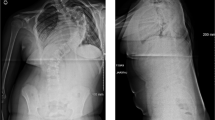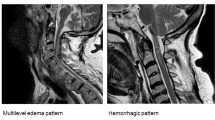Abstract
Introduction
Spontaneous spinal epidural hematoma (SSEH) is the rarest cause of spinal cord compression, causing paraparesis or quadriparesis. They account for less than 1% (0.1 patients per 100,000 patients per year) of all spinal canal space-occupying lesions, thus resulting in a paucity of literature. Here, we report three cases of SSEH; all had a neurological deficit on presentation and were surgically managed with decompressive laminectomy and evacuation of the hematoma.
Case presentation
Of the three patients, one had a history of coronary artery disease and was on anticoagulants. In the remaining two, no cause could be identified. The hematoma was located at the thoracic region in 2 patients and at the cervical in one. Hematoma were located dorsal to cord in 2 patients and ventral in one. Two cases presented within 30 h of the onset of symptoms with the ASIA (American Spinal Injury Association) impairment scale (AIS) A and B neurology. Both showed a complete recovery during their latest follow-up. However, one case presented after 2 days with AIS A neurology and improved to AIS B post-operatively at 30 months follow-up.
Discussion
The myriad of symptoms and the need for an MRI for diagnosis have made SSEH difficult to diagnose clinically. Unlike other spinal pathologies where the severity of the preoperative neurological deficit is the best predictor of prognosis, in SSEH, time is the best predictor of prognosis. Our series highlights the fact that irrespective of the severity of the preoperative neurological deficit, timely diagnosis and early, adequate decompression surgery are essential for complete neurological recovery.
This is a preview of subscription content, access via your institution
Access options
Subscribe to this journal
Receive 1 print issues and online access
We are sorry, but there is no personal subscription option available for your country.
Buy this article
- Purchase on SpringerLink
- Instant access to full article PDF
Prices may be subject to local taxes which are calculated during checkout



Similar content being viewed by others
Data availability
All data generated or analyzed during this study are included in this published article.
References
Holtås S, Heiling M, Lönntoft M. Spontaneous spinal epidural hematoma: findings at MR imaging and clinical correlation. Radiology. 1996;199:409–13.
Groen RJ, Ponssen H. The spontaneous spinal epidural hematoma. A study of the etiology. J Neurol Sci. 1990;98:121–38.
Liao CC, Lee ST, Hsu WC, Chen LR, Lui TN, Lee SC. Experience in the surgical management of spontaneous spinal epidural hematoma. J Neurosurg. 2004;100:38–45.
Foo D, Rossier AB. Preoperative neurological status in predicting surgical outcome of spinal epidural hematomas. Surg Neurol. 1981;15:389–401.
Lefranc F, David P, Brotchi J, De Witte O. Traumatic epidural hematoma of the cervical spine: magnetic resonance imaging diagnosis and spontaneous resolution: case report. Neurosurgery. 1999;44:408–10.
Cullen DJ, Bogdanov E, Htut N. Spinal epidural hematoma occurrence in the absence of known risk factors: a case series. J Clin Anesth. 2004;16:376–81.
Fukui MB, Swarnkar AS, Williams RL. Acute spontaneous spinal epidural hematomas. AJNR Am J Neuroradiol. 1999;20:1365–72.
Wang M, Zhou P, Jiang S. Clinical features, management, and prognostic factors of spontaneous epidural spinal hematoma: analysis of 24 cases. World Neurosurg. 2017;102:360–9.
Lonjon MMC, Philippe P, Chanalet S, Grellier P. Nontraumatic spinal epidural hematoma: report of four cases and review of the literature. Neurosurgery. 1997;41:483–7.
Handbook of Clinical Neurology [Internet]. [cited 2023 Oct 8]. Available from: https://www.elsevier.com/books-and-journals/book-series/handbook-of-clinical-neurology.
Beatty RM, Winston KR. Spontaneous cervical epidural hematoma. A consideration of etiology. J Neurosurg. 1984;61:143–8.
Gopalkrishnan CV, Dhakoji A, Nair S. Spontaneous cervical epidural hematoma of idiopathic etiology: case report and review of literature. J Spinal Cord Med. 2012;35:113–7.
Avrahami E, Tadmor R, Ram Z, Feibel M, Itzhak Y. MR demonstration of spontaneous acute epidural hematoma of the thoracic spine. Neuroradiology. 1989;31:89–92.
Aycan A, Ozdemir S, Arslan H, Gonullu E, Bozkına C. Idiopathic thoracic spontaneous spinal epidural hematoma. Case Rep Surg. 2016;2016:5430708.
Clarke DB, Bertrand G, Tampieri D. Spontaneous spinal epidural hematoma causing paraplegia: resolution and recovery without surgical decompression. Neurosurgery. 1992;30:108–11.
Connolly ES, Winfree CJ, McCormick PC. Management of spinal epidural hematoma after tissue plasminogen activator. A case report. Spine. 1996;21:1694–8.
Groen RJM. Non-operative treatment of spontaneous spinal epidural hematomas: a review of the literature and a comparison with operative cases. Acta Neurochir. 2004;146:103–10.
Ainslie JP. Paraplegia due to spontaneous extradural or subdural haemorrhage. Br J Surg. 1958;45:565–7.
Correa AV, Beasley BA. Spontaneous cervical epidural hematoma with complete recovery. Surg Neurol. 1978;10:227–8.
Groen RJ, van Alphen HA. Operative treatment of spontaneous spinal epidural hematomas: a study of the factors determining postoperative outcome. Neurosurgery. 1996;39:494–508.
McQuarrie IG. Recovery from paraplegia caused by spontaneous spinal epidural hematoma. Neurology. 1978;28:224–8.
Lawton MT, Porter RW, Heiserman JE, Jacobowitz R, Sonntag VK, Dickman CA. Surgical management of spinal epidural hematoma: relationship between surgical timing and neurological outcome. J Neurosurg. 1995;83:1–7.
Author information
Authors and Affiliations
Contributions
SR and VTa helped in the conception or design of the work. GK, SK, VTh, AM, BRJ, and CM helped in the acquisition, analysis, or interpretation of data, drafted the work or revised it critically for important intellectual content, approved the version to be published, and agreed to be accountable for all aspects of the work in ensuring that questions related to the accuracy or integrity of any part of the work are appropriately investigated and resolved.
Corresponding author
Ethics declarations
Competing interests
The authors declare no competing interests.
Ethics approval and consent to participate
Ethics approval was waived by our institution’s Institutional Review Board. Consent to participate was obtained from all the patients.
Consent for publication
Consent to publish was obtained from all the patients.
Additional information
Publisher’s note Springer Nature remains neutral with regard to jurisdictional claims in published maps and institutional affiliations.
Rights and permissions
Springer Nature or its licensor (e.g. a society or other partner) holds exclusive rights to this article under a publishing agreement with the author(s) or other rightsholder(s); author self-archiving of the accepted manuscript version of this article is solely governed by the terms of such publishing agreement and applicable law.
About this article
Cite this article
Raju, S., Tandon, V., Kumar, G. et al. Spontaneous spinal epidural hematomas—Time is running out!. Spinal Cord Ser Cases 10, 78 (2024). https://doi.org/10.1038/s41394-024-00693-8
Received:
Revised:
Accepted:
Published:
DOI: https://doi.org/10.1038/s41394-024-00693-8



